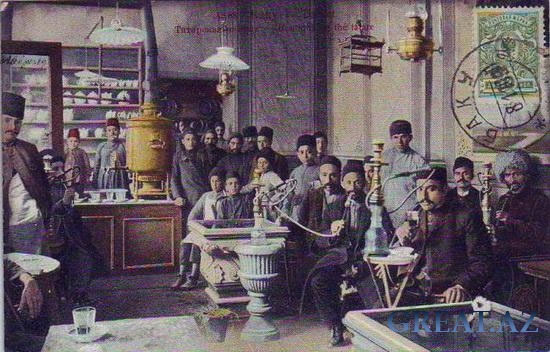 Bakı, əsrlərin qovuşuğunda çayxana. “great.az” foto-kolleksiyasından
Bakı, əsrlərin qovuşuğunda çayxana. “great.az” foto-kolleksiyasındanRusiya mənşəli yəhudi olan Lev Nussimbaum 1905-ci ildə anadan olmuşdur (özü iddia etdiyinə görə Bakıda; doğum şəhadətnaməsinə görə Kiyevdə; sonradan alman polisi onun əsl mənşəyinin izinə düşdükdə irəli sürdüyünə görə Avropadan Asiyaya gedən qatarda ki, bu, simvolik olaraq ona çox yaraşardı). Adının xatirəsini saxlamaq üçün nə ölüm haqqında rəsmi sənədlər, nə də bir qəbir daşı var. Lev Nussimbaum 1922-ci ildə, Berlində qeyb olur, Əsəd Bəyin ilk dəfə meydana çıxdığı eyni il və eyni yerdə. Hər iki ad, Lev və Əsəd, uyğun dillərdə “şir” deməkdir.
Rus yəhudisi və azərbaycanlı şahzadə, heç vaxt anadan olmamış və heç zaman vəfat etməmiş insan əslində eyni şəxsdir.
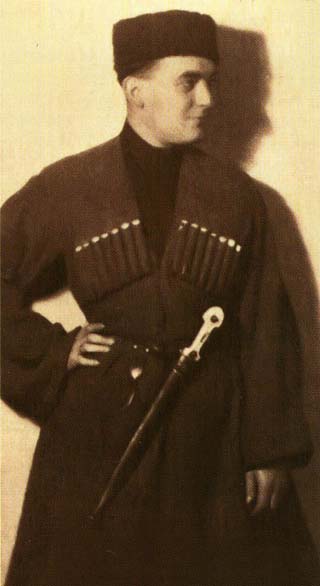 “Qafqazın on iki sirri” əsərinin ingilis dilindəki nəşrinin titul vərəqi ilə üzbə-üz qafqazlı dağlı geyimində təsvir olunmuş Əsəd Bəy, Nyu-York: “Viking Press”, 1931 (AI 15 (2011) 2-4)
“Qafqazın on iki sirri” əsərinin ingilis dilindəki nəşrinin titul vərəqi ilə üzbə-üz qafqazlı dağlı geyimində təsvir olunmuş Əsəd Bəy, Nyu-York: “Viking Press”, 1931 (AI 15 (2011) 2-4)1900-cü illərin əvvəlləri Azərbaycan dünyada neftə olan tələbatın tən yarısını təmin edirdi. Levin atası, ukraynalı əşkenazi Abram Nussimbaum keçmiş əmirlərin şöhrətinin kölgəsində müsəlman, yəhudi, xristian və zərdüştilərin yan-yana yaşadığı, o zamanın varlı və kosmopolit şəhəri, Xəzər dənizinin sahilində əsl Qafqaz incisi olan Bakıda məskən salaraq sərvətini qara qızıldan qazanmışdı. Levin anası, belarus yəhudisi Berta Slutski bolşevik inqilabçısı idi və gənc Stalinlə dost olduğu söylənirdi (Lev onun Bakıda bir neçə ay Nussimbaumların evində qalmağını iddia etməyi sevərdi). Bəlkə də Berta neft maqnatı Nussimaumla partiyanın tələbinə görə yüksək burjua dairələrinə daxil olmaq üçün evlənmişdi, 1911-ci ildə ifşa edildikdə isə sulfat türşüsu içərək özünü zəhərləmişdi. Balaca Lev alman dayə tərəfindən tərbiyə olunmuş, gənc Nussimbaum alman dilindi məhz ondan öyrənmiş və beləliklə həyat yolunu cızmışdı.
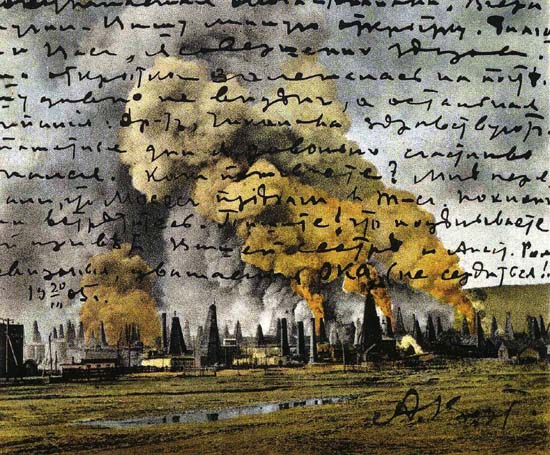 Rus və fransız dillərində yazılmış açıqca: “Bibi-Heybətdəki üç fontan alovlar içində.
Rus və fransız dillərində yazılmış açıqca: “Bibi-Heybətdəki üç fontan alovlar içində.Bakı, 14 sentyabr 1903-cü il”. Bibi-Heybət dənizə yaxın, Bakının qərb tərəfində yerləşən ən zəngin neft sahələrindən biri idi (AI 15 (2011) 2-4)
Sonralar yazdığı kitablarda iddia etdiyinə görə Birinci Dünya Müharibəsi başa çatdıqdan və Rusiyada 1917-ci il inqilabı baş verdikdən sonra Lev və onun atası birinci dəfə Türküstandan keçib İrana qaçmağa məcbur oldular. Onlar 1919-cu ildə dünyanın ilk müsəlman parlament respublikası olan qısa ömürlü Azərbaycan Demokratik Respublikasına qayıtdılar. Ölkənin Qızıl Ordu tərəfindən işğalından sonra onlar Bakını ikinci dəfə sərgüzəşt dolu bir yolla tərk etdilər. Əvvəl xilafətin son dövrlərində Konstantinopolda qalırlar, sonra Parisdə və nəhayət Berlində ki, orada Lev Şərqşünaslıq Fakültəsinə qəbul olur. O daha heç zaman doğma yerləri görməyəcəkdi, xatirələrində tolerant İslamın və Şərqin cazibədarlığı və kosmopolitizmini ideallaşdırırdı, elə orada da özünə sığınacaq tapmaq qərarını verdi. 1922-ci ildə Türk səfirliyinin imamı qarşısında yəhudi Lev Nussimbaum yoxa çıxaraq İslamı qəbul etmiş müsəlman şahzadə Əsəd Bəyə yol verir. Daha sonra çəkilmiş portreti onu başında fəs təsvir edir.
Lev özü üçün ölümünə qədər sadiq qalacağı bir uydyrma kimlik fikirləşir, lakin ətrafındakı dünyalar durmadan yoxa çıxır: ideallaşdırılmış və itirilmiş qədim Bakıdan sonra, müasir Türkiyənin atası Atatürk fəs qoymağı qadağan edir, şərəfli “Bəy” titulunu ləğv edərək hamıdan sıravi soyadları götürməyi tələb edir.
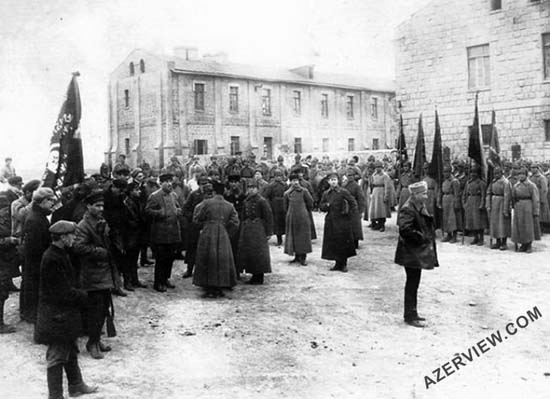 Qızıl ordu 1920-ci ilin mayı Bakıda. “azerview.com” foto-kolleksiyasından
Qızıl ordu 1920-ci ilin mayı Bakıda. “azerview.com” foto-kolleksiyasından24 yaşında Əsəd Bəy alman dilində ilk bestselleri olan “Şərqdə qan və neft”i nəşr etdirir. Öz qısa həyatında o, bir çox dillərə tərcümə olunmuş daha bir düjün kitab, o cümlədən Məhəmməd peyğəmbər, Lenin və Stalin, İkinci Çar Nikolay və Rza Şah Pəhləvinin bioqrafiyalarını yazır. Əsərləri Veymar Almaniyasının ən böyük naşirləri tərəfindən çap olunur, alman və avstriya jurnalları üçün yazır, çoşqun sevgi həyatına görə dedi-qodu səhifələrinin qəhrəmanına çevrilir, o dövrün sürgündə olan saxta müsəlman şahzadəsinin ekzotikliyi ilə ovsunlanmış intellektuallar dünyasına daxil olur.
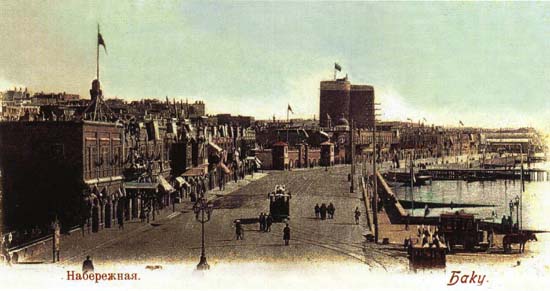 Bakı, Xəzər dənizinin sahilində Bulvar, solunda orta əsrin köhnə şəhəri və
Bakı, Xəzər dənizinin sahilində Bulvar, solunda orta əsrin köhnə şəhəri vəarxa fonda erkən orta əsrə aid Qız Qalazı ilə (AI 15 (2011) 2-4)
Əsəd Bəy hesab edirdi ki, yəhudi və müsəlmanlar Qərb modernizmi deyil, Şərq və ənənəvi dəyərlərini qəbul edərək öz ümumi semit köklərini möhkəmləndirməlidirlər. Lakin eyni zamanda ailəsinin başına gəlmiş bədbəxtliklərə görə ölümünə qədər müharibə elan etdiyi Kommunizmə qarşı Qərbi yeganə istehkam hesab edirdi. Şərq və Qərb arasında sintez Lev-Əsədin həyatı boyu təqib etdiyi utopiyaya çevrilir.
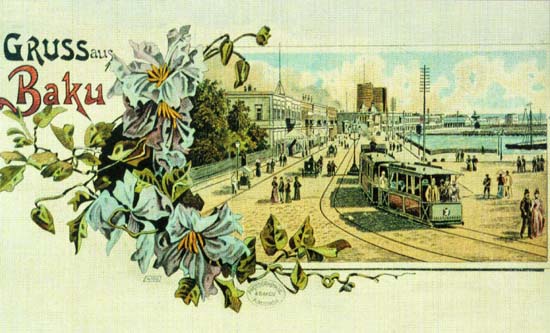 Eyni yer təxminən 1900-cu ildə, qoşqusuz tramvay və telefon dirəkləri ilə (AI 15 (2011) 2-4)
Eyni yer təxminən 1900-cu ildə, qoşqusuz tramvay və telefon dirəkləri ilə (AI 15 (2011) 2-4)Lakin ətrafında hər şey dəyişməkdə davam edirdi. 1933-cü ildə Nasional Sosializmin yüksəlişi ilə Vaymar Respublikası tarixdən silinir, bundan sonrakı irqi qanunlar yəhudilərə alman dilində nəşr olunmağı qadağan edir. Almaniyada Əsəd Bəyin əsl kimliyi barədə şayiələr gəzir, o, Yazıçılar Birliyindən xaric olunaraq yeni Qurban Səid psevdonimi ilə yazmağa məcbur olur. Əsəd Bəy yəhudi atası (o, 1941-ci ildə Treblinka düşərgəsində vəfat edəcəkdi) ilə birlikdə Berlində yaşamaqda ikən özünün əsl müsəlman kimliyini müdafiə etməkdə davam edir.
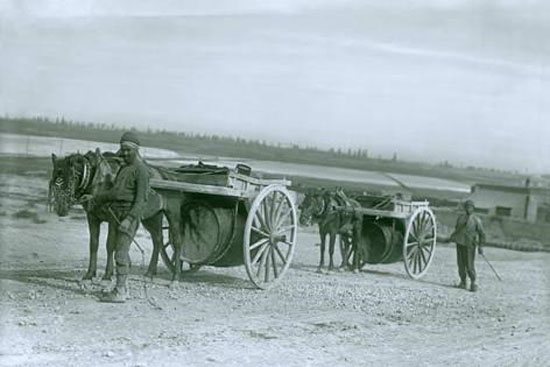 Bakıda neft daşıyan arabalar. Fotoqraf: Karl Bulla, 1905
Bakıda neft daşıyan arabalar. Fotoqraf: Karl Bulla, 1905Lakin bu zaman yeni bir macəra başlayırdı, Əsəd Bəy kitablarının xüsusi uğur qazandığı, rejimin ən yüksən dairələrində dəstək və rəğbət gördüyü Faşist İtaliyasında yeni çətinliklərlə üzləşir. Filosof və pedaqoq Covanni Centile onu xüsusilə dəstəkləyərək Duçe ilə görüşdürməyə çalışır (bu görüş planları yazıçının əsl mənşəyi barədə polis arayışı nəticəsində pozuacaqdı). Əsəd sionizmin Mussolini Faşizmini britaniyalı düşmənin düşməni və siyasi ideya mənbəyi kimi görən müəyyən sağ-qanadının mövqelərinə yaxın olur. Əsəd Bəy 1936-cı ildə sağçı sionizmin atası, Odessalı Zeev Vladimir Jabotinskinin Revizionist partiyasında ikinci şəxs olan Volfqanq fon Vayzl ilə birlikdə “Allah böyükdür” kitabını nəşr etdirir. O vaxtlar (1938-ci ilin irqi qanunlarına qədər) İtaliya dövləti də sionist ekstremistlərin bu diqqətini cavabsız qoymadı: otuzuncu illərdə Çivitavekkya Dənizçilik Məktəbində Jabotinskinin Revizionist partiyası ilə əlaqəli millətçi gənclər hərəkatı Betarın üzvü olan yəhudi gənclər üçün ilk sinif açıldı. Sinfin başçısı gənc və savadlı Litva yəhudisi, məşhur ravvin ailəsinin oğlu, italyan faşizminə heyran olmuş anti-kommunist (ivrit dilində Mussolininin ilk bioqrafiyasını 1936-cı ildə, Tel-Əvivdə nəşr etdirəcəkdi) və bir neçə il sonra qeyri-dəqiqliyi ilə məşhur “Yosl Rakover Allahla danışır” hekayəsinin müəllifi Tsvi Kolits idi.
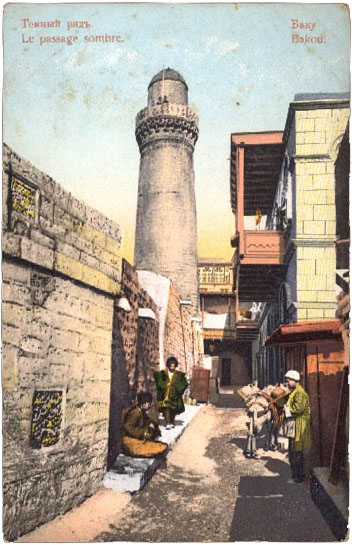 Bakıda, köhnə şəhərdə xalça tacirləri
Bakıda, köhnə şəhərdə xalça tacirləriİctimaiyyətin diqqət mərkəzində olan bir şəxs kimi şöhrətinin zirvəsi olan ABŞ-a səfərindən qaydan Əsəd Bəyi həyat yoldaşı, yəhudi Erika Lövendal yazıçı Rene Fülop-Müllerlə birlikdə olmaq üçün tərk edir. Həyatında yer alan böyük eşqinin puç olması Əsəd Bəyin qısa müddətə psixiatrik müəssisədə müalicə almasına gətirir. Daha sonra “şahzadə” nadir və o zaman müalicə olunmayan bir xəstəliyə, barmaqların qanqrenaya gətirən göyərməsi ilə müşayət olunan Reyno fenomeni və ya başqa bir qənaətə görə Bürger xəstəliyinə tutulur. “Anşlüs” onu Avstriyada yaxalayır və o, İsveçrə ərazisindən keçərək cənubi İtaliyada, Amalfi sahil xəttində, dəniz üzərindəkı yüksəklikdə yerləşən bir balıqçı kəndi olan Pozitanoya qaçır. İren Kovaliska xatırlayır ki, o illər Pozitano nasist ordularının işğal etdiyi bir çox avropa ölkələrindən olan siyasi qaçqın və yəhudilər üçün sığınacaq yeri idi. Kovaliska ilə Pozitanoda yaşayan alman şairi Armin Teofil Veqner müsəlman-yəhudi Lev-Əsəd barədə deyir ki, “ömrünün sonuna doğru o, şarada-tapmaca oynamağı sevərdi”.
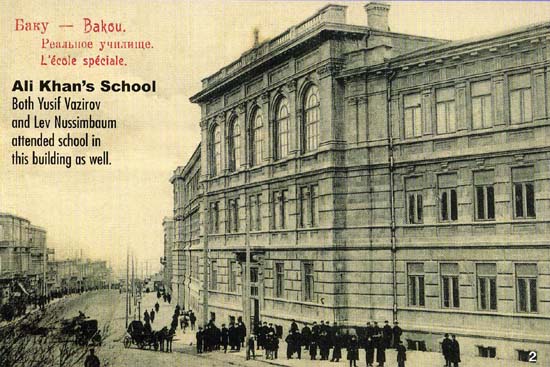 Təxminən 1900-cü il, Bakı Realnı Məktəbi. Həm Lev Nussimbaum,
Təxminən 1900-cü il, Bakı Realnı Məktəbi. Həm Lev Nussimbaum,həm də “Əli və Nino” romanının xəyali qəhrəmanı Əli bu məktəbə getmişdir.
İndi isə bu, İqtisadiyaat Universitetidir (AI 15 (2011) 2-4)
Dünyanın ucqar bir yerində bu təcrid olunmuş və kosmopolit sığınacaq yerinə Əsəd Bəy kitablarının müəllif hüquqlarından əldə etdiyi üç min lirə, o zaman üçün boyuk məbləğ saxlanan hesabın bank kitabçası ilə gəlmişdi. Lakin müharibənin gəlişi ilə naşirlər qonorar ödəməyi dayandırır və Əsəd Bəy o qədər kasıblayır ki, sağ qalmaq üçün öz dostları və Pozitano sakinlərinin köməyindən asılı olur. Xəstəliyi də getdikcə pisləşir, dözülməz ağrıları yüngülləşdirmək üçün həkim ona morfi göstərişi yazır, amma Əsəd Bəyin dərman almaq imkanı olmur. 1939-cu ildə Neapolda tədricən sol ayağının barmaqları amputasiyaya məruz qalır. Onun yəhudi mənşəyindən çoxdandır ki xəbərdar olan faşist polisi onu irqi qanunlara görə həbs etmək əvəzinə bu əməliyyata lazım olan pulu tapmaq üçün fəaliyyətə keçir, bu işə həm də Daxili İşlər, Xarici İşlər və Mədəniyyət Nazirliklərində Neapol, Salerno və Pozitanonun rəsmi hökumət orqanları cəlb olunur.
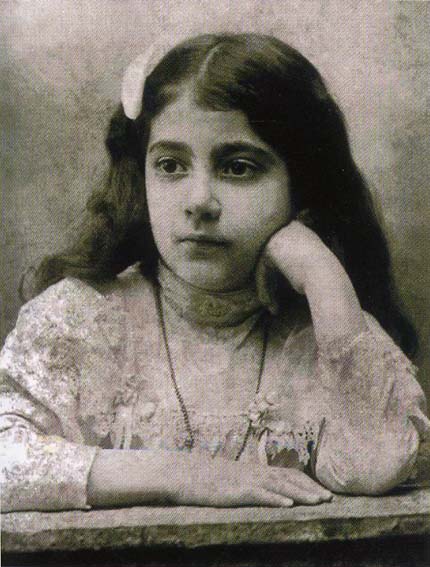 Sara Aşurbəyli, neft maqnatı ailəsinin qızı, sonradan Bakı və Şirvanşahlar dövlətinin tarixini öyrənən böyük alim (onun adı əvvəlki yazımızda da çəkilərək şəkilləri verilib) (AI 15 (2011) 2-4)
Sara Aşurbəyli, neft maqnatı ailəsinin qızı, sonradan Bakı və Şirvanşahlar dövlətinin tarixini öyrənən böyük alim (onun adı əvvəlki yazımızda da çəkilərək şəkilləri verilib) (AI 15 (2011) 2-4)Ömrünün son dövründə Əsəd Bəyə Rapallo ledisi Pima Andreə - yazıçı və rəssamların, xüsusən də dramaturq Gerhart Hauptmanın böyük dostu kömək edir. Məhz adı axırıncı çəkilən bu şəxs ona həyəcan xəbəri göndərir ki, “Şərqdə qan və neft”in məşhur müəllifi böyük ehtiyac içində Pozitanoda yaşayır. Andreə isə ehtiyac içində yaşayan yazıçıların acınacaqlı vəziyyətinə həssas yanaşan və Əsəd Bəyin kitabları ilə maraqlanan Ezra Paunda (kitablardan biri, “Qafqazın sirləri”nə o öz “Ölümdən sonra nəğmələr”inin bir hissəsində istinad edib) bu barədə məlumat verir. Paund ona nail olur ki, Əsədi əməkdaşlıq etdiyi Roma propaqanda departamentinə işə götürürlər. Asiyada translyasiya olunacaq radio proqramların bəzi müsahibələrini lentə almaq üçün Levi İtaliya Dövlət Radiosundakı studiyaya aparmaq məqsədi ilə 1942-ci ildə Pozitanoya mavi bir avtomobil gəlir. Lakin maşın çox gec gəlib çıxır. Əsəd bəy bir neçə gün əvvəl, avqustun 27-si, cəmi-cümlətanı 36 yaşında, xəstəlikdən zəifləyərək vəfat edir.
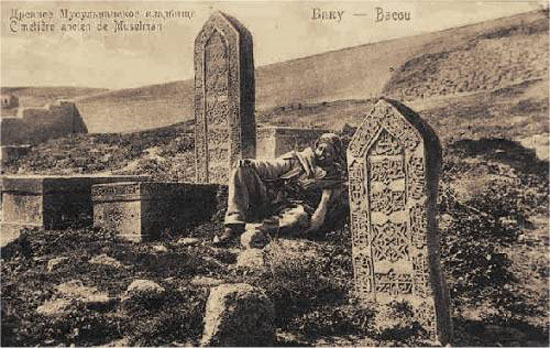 Bakı, köhnə müsəlman qəbristanlığı
Bakı, köhnə müsəlman qəbristanlığıÖz istəyinə əsasən onu Pozitanodakı balaca qəbristanlıqda dəfn edirlər. Ancaq 2008-ci ildə Məkkəyə doğru döndərilmiş qəbir türk üslubunda hazırlanıb və başında daşdan çalma var. Baş daşında Əsəd Bəyin adından başqa Quranın ilk surəsinin birinci ayəsi oyulub: بسم الله الرحمن الرحيم, bismillāhi-rrahmani-rrahīm, rəhmli və rəhmdil Allahın adı ilə. Bütün xərclər əl-cəzairli jurnalist, paraşüt-desantçı və faşist İtaliyasının casusu Əhməd Cəmil Vakka Madzara tərəfindən ödənmişdi. Elə Əhməd Cəmilin uydyrma kimliyi də bu əhvalatla tam səsləşir, onun əsl adı Bello Vakko, özü isə Tirpolidə anadan olmuş İtaliya vətəndaşı, Qahirədə yaşayarkən İslamı qəbul etmiş keçmiş ehtiyat zabiti idi.
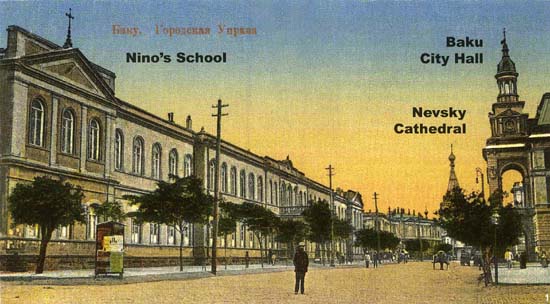 Müqəddəs Nino məktəbi “Əli və Nino: Məhəbbət hekayəsi” romanında gürcü Ninonun liseyinin prototipi. Məktəbin tarixi barədə təfərrüatlarla dolu əvvəlki yazımıza nəzər yetirin. Arxa fonda görünən Nevski baş kilsəsi Çar III Aleksandrın fərmanı ilə müsəlman qəbristanlığının yerində tikilmiş, 1936-cı ildə isə dağıdılmışdı (AI 15 (2011) 2-4)
Müqəddəs Nino məktəbi “Əli və Nino: Məhəbbət hekayəsi” romanında gürcü Ninonun liseyinin prototipi. Məktəbin tarixi barədə təfərrüatlarla dolu əvvəlki yazımıza nəzər yetirin. Arxa fonda görünən Nevski baş kilsəsi Çar III Aleksandrın fərmanı ilə müsəlman qəbristanlığının yerində tikilmiş, 1936-cı ildə isə dağıdılmışdı (AI 15 (2011) 2-4)Lakin yəhudi-azəri-türk şahzadəsinin müxtəlif həyatlarının sirləri ölümündən sonra da bitmək bilmir. Əsəd Bəy 1937-ci ildə, Avstriyada Qurban Səid təxəllüsü altında “Əli və Nino: Məhəbbət hekayəsi” romanını nəşr etdirmişdir. Tez bir zamanda beynəlxalq uğur qazanaraq artıq 33 dilə tərcümə edilmiş bu kitab müsəlman Romeo (azəri Əli) və xristian Cülyetta (gürcü Nino) arasında məhəbbət hekayəsindən bəhs edir və Nussimbaum-Bəy üçün vacib olan bir sualla başlayır: “Bəs biz Bakılılar Avropalıyıq, yoxsa Şərqli?” Şərqə bağlı və Qərbə heyran olan Əli qədim azərbaycan şəhəri Gəncəni Rusların hücumudan qoruyarkən həlak olur. Bu romanın milli ədəbi abidə hesab olunduğu Azərbaycanda Əsəd Bəy və Qurban Səidin eyni şəxs olduğunu hamı qəbul etmir, romanı milli yazıçı Yusif Vəzir Çəmənzəminliyə aid edirlər. Almaniyada isə hesab edirlər ki, Qurban Səid avstriyalı Baronessa Elfrida fon Bodmershof fon Erelfelsin təxəllüsüdür. Əslində, Əsəd Bəy bir yəhudi kimi alman dilində çap oluna bilmədiyindən dostu olan Baronessa ilə (onun əri də İslamı qəbul etmişdi) əsərlərinin müəlliflik hüququnu onun adına yazdırmaq barədə razılaşmışdı.
Şahzadə Əsəd Bəy, Qurban Səid, yazıçı Yusif Vəzir Çəmənzəminli (burada gürcü Qriqol Robakidze də qeyd edilməlidir) və Baronessa Elfrida fon Bodmershof fon Erelfels: Şərq və Qərb arasında bir kitabın və bu qədər dünyanı dəyişmiş illərin birləşdirdiyi neçə ömür, neçə ad. Lev Nussimbaum bu hekayəni əlbəttə ki bəyənərdi.
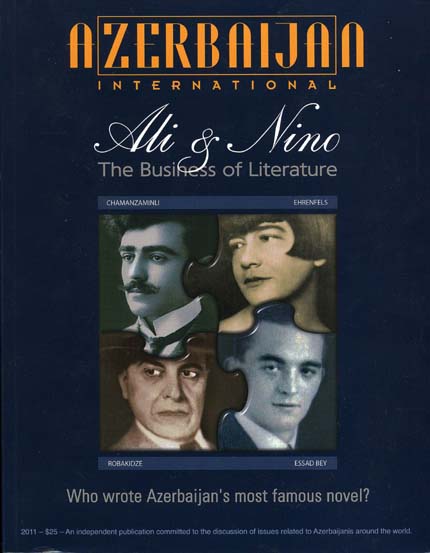 “Əli və Nino”nun müəllifi kimi irəli sürülən dörd namizəd.
“Əli və Nino”nun müəllifi kimi irəli sürülən dörd namizəd.Bu yazının illüstrasiyaları “Azerbaijan International” jurnalının “Əli and Nino. Ədəbiyyat biznesi. Azərbaycanın ən məşhur romanının müəllifi kimdir?” sualına həsr olunmuş sonuncu, 15 (2011) 2-4 buraxılışından götürülmüşdür. Həm Əsəd Bəy, həm də “Əli və Nino”da təsvir edilmiş ötən əsr Bakısının gündəlik həyatı və mədəniyyəti barədə ən təfsilatlı bir tədqiqatın hesabatı olan bu nəşr Yusif Vəzirin müəllifliyini dəstəkləyən inandırıcı arqumentlər gətirir. Onu bir neçə gün əvvəl Bakının qədim şəhər qismində yerləşən sonuncu köhnə ikinci əl kitab dükanında aldıq və tezliklə həm bu dükan, həm bu nəşr, həm də jurnalın təsvir etdiyi itirilmiş Bakı barədə yazacağıq.
• Əsas mənbələr:
- Tom Reyss, “The Orientalist”, “Random House”, 2005
- Françesko M. Kataluççio, “Vado a vedere se di là è meglio”, “Sellerio”, 2010
- Massimo İntrovinye, “Essad Bey (alias Kurban Said)”, “Il Domenicale”, 2005, n.4
- Stenio Solinas, “Le tante identità di Mohammed Essad Bey”, “Leadership Medica” 2004, n.4
• Əsəd Bəyin qəbrinin foto-şəkli
• Pozitanonun foto-şəkli
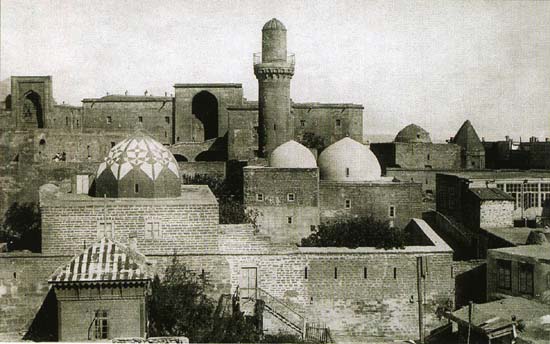 Bakı, Şirvanşahlar sarayı. 19-cu əsrin sonları (AI 15 (2011) 2-4)
Bakı, Şirvanşahlar sarayı. 19-cu əsrin sonları (AI 15 (2011) 2-4)























































